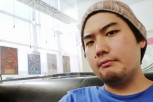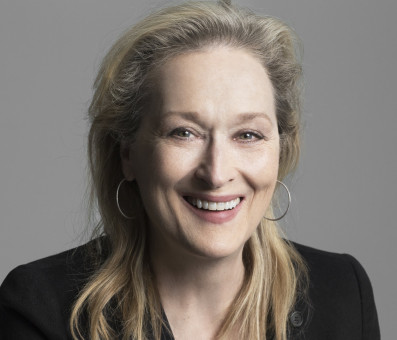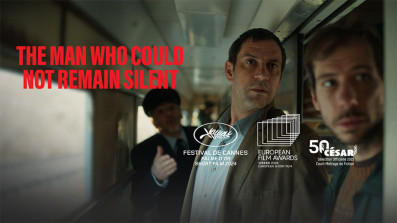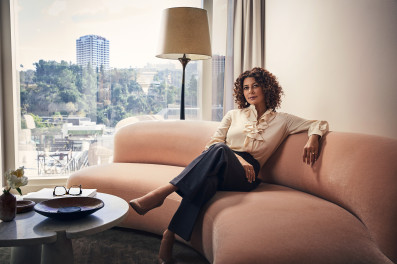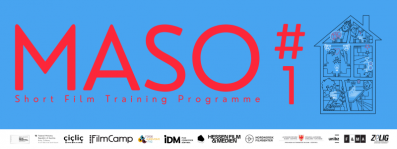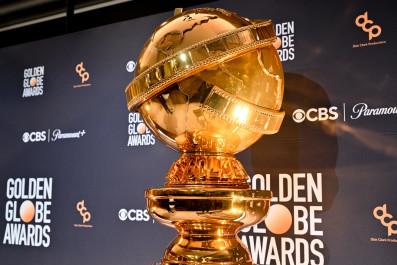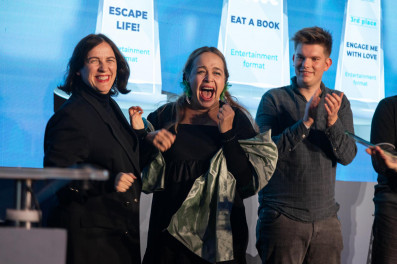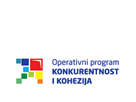Interview with Marieke Elzerman, the director of "Kom Hier"
"I’d rather tried to think of the situations that they would get in to, and how they would interact with each other."
Marieke Elzerman (born in Amsterdam, 1996) studied at the film academy KASK in Ghent, where she was tutored amongst others by Renzo Martens, renowned for his film Enjoy Poverty. She made a short film Moises y el pajaro (2018) under the guidance of Werner Herzog. Her graduation film from KASK is Kom hier (2020). Currently she is enrolled at the Elías Querejete Zine Eskola in San Sebastián. This time, Japanese cinema magazine Z-SQUAD and Tettyo Saito interviewed her about Kom hier, one of the best films about life and love in 2021.
At first, why do you want to become a film director? How did you become a film director?
It was a childhood dream at first because my father and I always went to the cinema on Saturdays and I got super excited about making films. But in high school, I forgot about it and wanted to do something in economics. But then in my last year of high school, I participated in a film project for the Anne Frank House. We had to make a small video on one of the themes of her diary. It was the first time I filmed and edited something. I fell so in love with it and decided to study film!
When you started to be interested in films, what films did you watch? What films could you watch at that time in the Netherlands?
When I was a teenager I went to the more mainstream films, but they're also were some independent films that made an impression on me. For example, Winter’s Bone by Debra Granik, I remember vividly. But in my first year of KASK, I discovered so many filmmakers, like Chantal Akerman, Kelly Reichardt, Johan van der Keuken...
What is the starting point of "Kom hier"? Your own experience, news in the Netherlands or Belgium, or some other things?
It was a mix of things... I knew I wanted to make a film about a friendship between two girls, where one wants to reach out to the other and the other shy away, based on some experiences I had myself. But intuitively the place of the dog shelter was also there from the beginning. First, I wrote a script about two friends meeting again after a long time, but once I found the shelter in Ostend and met the people there, the story of the two friends also changed a lot. Some dialogues I had with the people there I took directly into the script. And also Koen’s class (which I followed in real life) also influenced the themes between the two friends.
"Kom hier" features a difficult but important relationship between human and animal. Living with otherness is always tough, but living with an animal is very different from living with someone, which is captured heartbreakingly and beautifully in this film. So, what is the most essential thing when you write about this relationship between human and animal both on the screenplay and on the set. And what is the most challenging when you make a film with animals?
What was so interesting for me, was the view Koen teaches about the upbringing of a dog. That it is not so much about demanding obedience from your dog, but rather to always guarantee safety, even if the dog acts not in a way that you want them to.
I thought a lot about the need for control in relationships. I realized that there is often a big need to control your dog, that when you shout 'Come here!'... your dog always comes. And I saw a similarity in some of the relationships I had with people: this complexity of wanting to get close to someone and trying to control this bonding in a way, and about the impossibility to do so, to control the growth of a relationship.
I think it is beautiful that Koen teaches that maybe the best thing to do is not to demand something but to offer some warmth and safety to the other so that the bond grows on its own. And as for the challenges with the animals… I owe a great deal to Koen, who always helped out with that. The dog of Eva, Klara, is his dog and they have a very special bond that made it very easy to let Klara act nervous.
One of the impressive things in this film is the place itself, somewhere in Ostend. A cold yet generous atmosphere embraces its protagonist Sam and other animals, while there is a tough reality at the same time. Still, the sequence, that Sam and her new friend talk on the night of Ostend, is beautiful and heartwarming. What in this place attracts you so much? How did you find this place?
Thank you so much for these words! I am so happy you felt that, it is exactly how I experienced Ostend, and mostly the shelter. While I did a writer's residency in Ostend, I visited the shelter. This duality of a warm environment and the harsh reality was very strong and attracted me a lot.
Every day, the people in the shelter were confronted with horrible stories about abandoned and mistreated animals. But there was such a warmness between the colleagues, and between them and the animals, that made it still feel like a safe space.
And I'm deeply impressed with the delicate relationship between two women which you depict in the film. At first, their eyes cross in silence at the room, then they talk about small things with some kind of clumsiness and then their honest words and hands touch each other in the happiness of living with otherness, which makes my eyes full of tears. So, what is the most important thing when you write about their relationship and their personality?
I was excited to write about an encounter, about the moments when you first meet someone and get to know that person. It was a difficult process to form the characters, to look for the words and the relationship they had. A big part was inspired by an encounter I had in the shelter. I lived in Brussels and entered that new world of shelter. I had some conversations with a young woman who volunteered there. She once asked me if I had a lot of friends, and I was so intrigued by that moment. And then I also based some of the dialogue on friendships I had in the past. I didn’t try to design the characters and their psychology, their backgrounds, so much, that didn’t give me so much energy. I’d rather tried to think of the situations that they would get into, and how they would interact with each other.
In relation to the previous question, the moving delicacy of their relationship is supported by the acting of two incredible actors Loes Swaenepoel and Anna Franziska Jäger. They capture speechless emotion in their heart in an exquisite way. How did you meet with Ms. Swaenepoel and Ms. Jäger? What is the biggest reason to decide to collaborate with them?
Loes and Anna Franziska both studied Acting at the same art school (KASK) as I did. I saw Anna Franziska act once in a play and reached out to her from very early on in the process before the script was written. We kept meeting during the process and had talked about her character, which was very enriching.
I met Loes two months before the shooting. First, I wanted to work with a volunteer who worked in the shelter, I wrote Sam a little bit based on her and on our conversations. But in the end, she said that she didn't want to do it, so I started casting Sam pretty late. It was such a great experience to meet Loes. We only did one rehearsal, but we talked about the film and I felt like we were all on the same line. That made it so easy to work on set together, we didn't have to do a lot of takes. I chose to work with them because their energies are so beautiful to me and I felt they had good chemistry.
And the core of this film is how you capture the gesture of the body, especially the protagonists' hands in the last sequence. Their hands dance under serene sunlight to tell each other about how difficult living with otherness is but how wonderful it is at the same time. Hands, which you capture, is hope itself in "Kom hier". So, what is the most essential thing when you capture these gestures with your cinematographer Frank Schulte, especially at its final sequence?
The collaboration with Frank was very smoothly and I learned a lot from it. He shoots primarily documentaries, and he has a very fast way to find an angle. Which was so great in this environment of the shelter, and because we only had 6 days to shoot the film. The shadows in the beginning of the film, were not scripted for example. We both saw that at the same time and shot it and that was such a nice way to work. The last scene we did without any rehearsal, which I regretted afterwards… But thank god Koen was there, and he instructed the way the girls had to use their hands. So there were no shot list or anything, we just ran around in the park, shooting a lot before the sun would go down. I spend a lot of time in the editing process on that scene. The smile of Sam in the end, for example, also wasn’t scripted, it was improvised by them while they were acting out these movements. I am very grateful for the acting, for Koen’s instructions and for Frank’s camera work that made the scene so much better than I could have written.
And I heard that you studied film directing at the academy KASK in Ghent. I want to ask about it. First, why did you choose KASK for studying film, not other film academies? How was your experience in KASK? Is there a wonderful personal memory which no one has except you?
I also tried to get into the Amsterdam Film Academy, but I wasn’t admitted, so I looked for film schools in Belgium. I am so happy I got admitted into KASK! I love that you don’t have to choose in between directing documentary or fiction. In the first two years, we had to make a lot, editing and filming a lot ourselves. And especially tutoring that guides you while you make a film, was the best experience… There is a strong focus on the process of making a film, which I think is a very unique way of teaching in film school. One of the coolest memories I have was a meeting with the students of KASK and Apichatpong Weerasethakul during the Rotterdam Festival. We all sat in a circle and talked about life and cinema… truly magical!
I found this interesting sentence in your profile on Festival Scope; "She made a short film Moises y el pajalo (2018) under the guidance of Werner Herzog." Werner Herzog! It seems too great, so I want to ask about this experience. How was the guidance of Werner Herzog? What did you feel when your mentor is Werner Herzog?
Haha, it was too great! I participated in the program where 48 young filmmakers went to the jungle of Peru, where we had two weeks to make a film and Herzog was there to guide us. It was a very expensive course, so I had my doubts, but it was such a transformative and heartwarming experience. Herzog was very approachable; his wife and his brother were also there and they interacted a lot with us. In the beginning, I was very shy. When I was shooting in the jungle, he came and watched me work. He left after a short time and the next day when I was editing, he said: ‘My heart sank when I saw you shooting yesterday. We are filmmakers, not garbage collectors!!!’ He meant that I was shooting a lot without making any selections… I was so nervous but after that, he saw the rest of the footage, he got excited and encouraged me to finish it that same day. When I presented the film that evening, he said that he was so proud and the day after he asked if he could sit with me at lunch! My heart was screaming of joy. The best experience during that course was also the realization that you can make a film in a very quick way. There were a lot of meetings with people, and we went to a lot of different places. To work with these real encounters and to make connections to them in order to find some sort of story, was such a great experience, that I also tried to took into ‘Kom hier’.
Do you have a plan for a new short or feature? If so, please explain to Japanese readers.
I am currently studying at the Elías Querejeta Zine Eskola in San Sebastian, Spain. Also an amazing academy! A bit similar to KASK, as they are also focusing a lot on the process of making a film. I am developing a short film around a group of women and men that are repairing, painting and clothing, big puppets for a Christmas stall in San Sebastian. It has been a long tradition to set up hundreds of big puppets in a central square. I was so intrigued by these puppets because they are painted in a very interesting way. I just visited the workshop where they repair all the hands and clothes, and it is just beautiful to see their work and create with so much care and delicacy. I am very excited to film these works and have this practical place as a starting point, just like the shelter in ‘Kom hier’ I guess!

